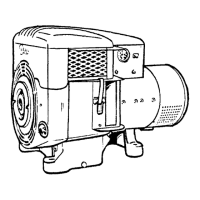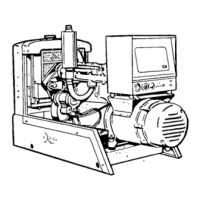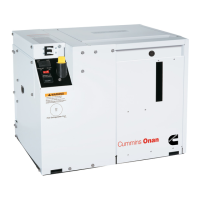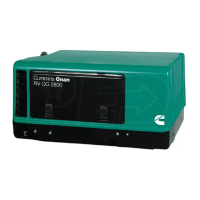EXHAUST
WARNING
Inhalation of exhaust gases can result in
death.
Engine exhaust gas must bepiped outside building or
enclosure. Do not terminate exhaust pipe near inlet
vents or combustible materials. An approved thimble
(Figure 6) must be used where exhaust pipes pass
through walls or partitions. Pitch exhaust pipes
downward or install a condensation trap (Figure 7) at
the point where a rise in the exhaust system begins.
Avoid sharp bends; use sweeping long radius elbows.
Provide adequate support for mufflers and exhaust
pipes.
Refer to Figure 3 for a typical exhaust installa-
tion.
Shield or insulate exhaust lines if there is danger
of personal contact. Allow at least 9-inches of
clearance if the pipes run close to a combustible wall
or partition. Use a pipe at least as large as the 3-inch
pipe size outlet df the engine with a flexible portion
. IF EXHAUST LINE MUST BE PITCHED UPWARD.
.CONSTRUCT A TRAP OF PIPE FITTINGS AT
POINT OF RISE
DRAIN CONDENSATION TRAP
B4,.i "WH PERIODICALLY
FIGURE 7. EXHAUST CONDENSATION TRAP
RAIN CAP
DRIP CAP
HOLES IN END OF
INNER SLEEVE
ROOF
• HOLES IN
Jf END OF
.,_ -'INNER SLEEVE
WALL OR PARTITION-
|[WHII|II|IB
NOTE VENTILATED THIMBLE DIAMETER 6" LARGER
B
4
,
THAN EXHAUST LINE
FIGURE 6. EXHAUST THIMBLE
between the engine and the muffler. Do not connect a
flexible line to the exhaust manifold. Minimum
diameters and maximum lengths of pipe are as
follows:
Single Exhaust system:
2'/2-inch pipe 58-feet
3-inch pipe 191-feet
3'/2-inch pipe 419-feet
Maximum permissible exhaust restriction (back
pressure) is 25-inches H2O .(1.84-inches Hg.).
13

